You can transfer data from your Pigment Views, Lists, Metrics, and Tables to Google Cloud Storage (GCS) with our REST API.
To do this, you create a Google Cloud function that runs a Python script. This script imports data from the Pigment API and stores it in CSV format in a storage bucket within a Google Cloud project.
Recommended reading
In case you need it, we’ve compiled some useful background information for you:
- Create a Google Cloud Project
- Create a Google Cloud Storage bucket
- Configure environment variables
- Create and access a secret using Secret Manager
- How to export data from Pigment with APIs
- How to trigger an import with APIs
Before you begin
We recommend that you use environment variables and Secret Manager to export your data. It is possible to hardcode the values for export_api_key and view_ID, however it doesn’t comply with security best practices.
Complete the following tasks in Google and Pigment before you start your export.
- Create a Google account
- Create a Google Cloud project
- Get your cloud project ID
- Create a Google Cloud storage bucket to store your Pigment API data
- Obtain your storage bucket ID
- Consult with your GCP admin to ensure a successful export workflow
Pigment
Only Pigment members with the account type Workspace Admin Workspace Admin or Security Admin can access the Access API key management page and manage API keys.
- Obtain your export API key. This is explained in Manage API Keys.
- Obtain your View ID. This is explained in How to export data from Pigment with APIs.
- Obtain your List, Metric, or Table IDs. This is explained in Export raw data from a Pigment Block.
Create a Google Cloud Function
Here’s how you create a Google Cloud function that loads Pigment API data into a storage bucket.
In the following example, we use view_ID, however you can use listID, metricID, or tableID as appropriate.
- In Google Secret Manager, create a secret using your export API key as a value.
- In the Cloud Functions dashboard, click Create Function.
- Update the values in the Basics panel:
- Environment: select 1st gen
- Function name: enter your function name
- Region name: select your region name
Create a function in the Cloud Functions dashboard - In the Trigger menu, select Cloud Pub/Sub.
- Create a new topic, and in the Topic ID field enter the topic name:
scheduler

Create a new topic in the Cloud Functions dashboard - Click the Runtime tab and use your own values to create a new environment variable called
view_ID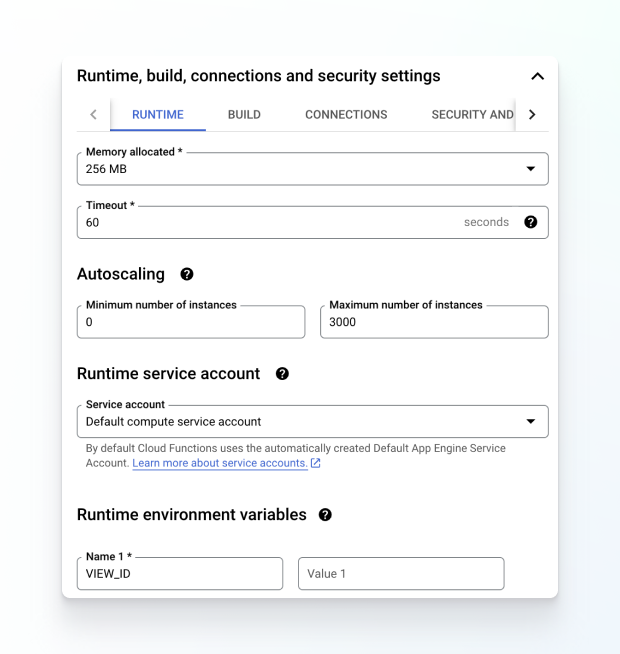
Create a new environment variable called view_ID - Click the Security and image repo tab and complete these steps:
a. In the Secret menu, select your secret.
b. In the Reference method menu, select: Exposed as environment variable
c. In the Name 1 field, enter:export_api_key
d. Click Next.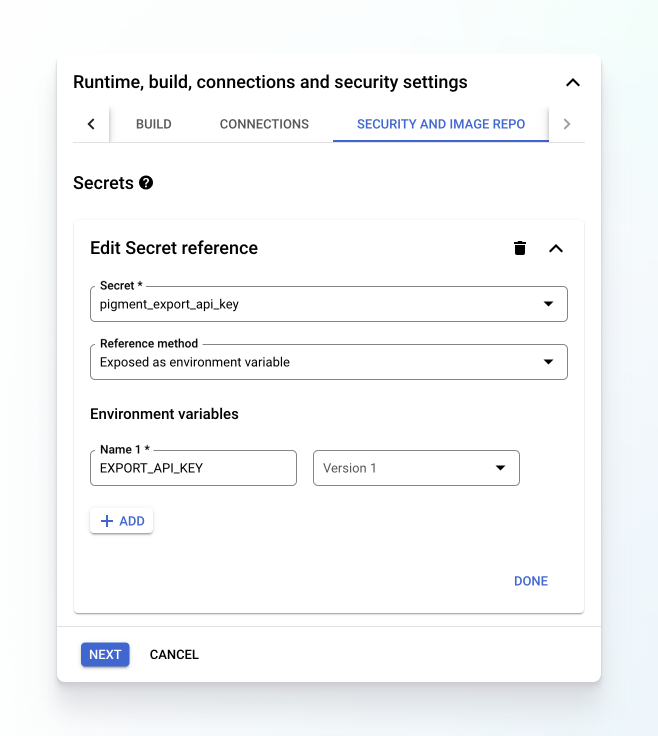
Edit the secret reference - In the Code pane, do the following:
a. In the Runtime menu, select Python 3.8.
b. Copy and paste this code into the file:main.pyimport os
import requests
from google.cloud import storage
EXPORT_API_KEY = os.environ.get('EXPORT_API_KEY')
VIEW_ID = os.environ.get('VIEW_ID')
API_URL = f'https://pigment.app/api/export/view/{VIEW_ID}'
HEADERS = {'Authorization': 'bearer '+EXPORT_API_KEY}
# Replace these with your own values
GCS_BUCKET_NAME = 'bucket-id'
GCS_FILE_NAME = 'filename.csv'
def download_csv_data_from_pigment(api_url):
response = requests.get(api_url, headers=HEADERS)
if response.status_code == 200:
return response.content
else:
raise Exception(f"Failed to download data from API. Status code: {response.status_code}")
def upload_to_gcs(bucket_name, file_name, data):
storage_client = storage.Client()
bucket = storage_client.bucket(bucket_name)
blob = bucket.blob(file_name)
# Upload the CSV data to the GCS bucket
blob.upload_from_string(data, content_type='text/csv')
def main(data, context):
csv_data = download_csv_data_from_pigment(API_URL)
upload_to_gcs(GCS_BUCKET_NAME, GCS_FILE_NAME, csv_data)
return "CSV data successfully fetched from API and uploaded to GCS."
c. In the Entry point field, enter the value:main
d. In your code, replace the valuebucket-idwith your Cloud Storage bucket ID.
e. (Optional) Rename the file:filename.csv
This is the CSV file where Pigment data is stored in your bucket.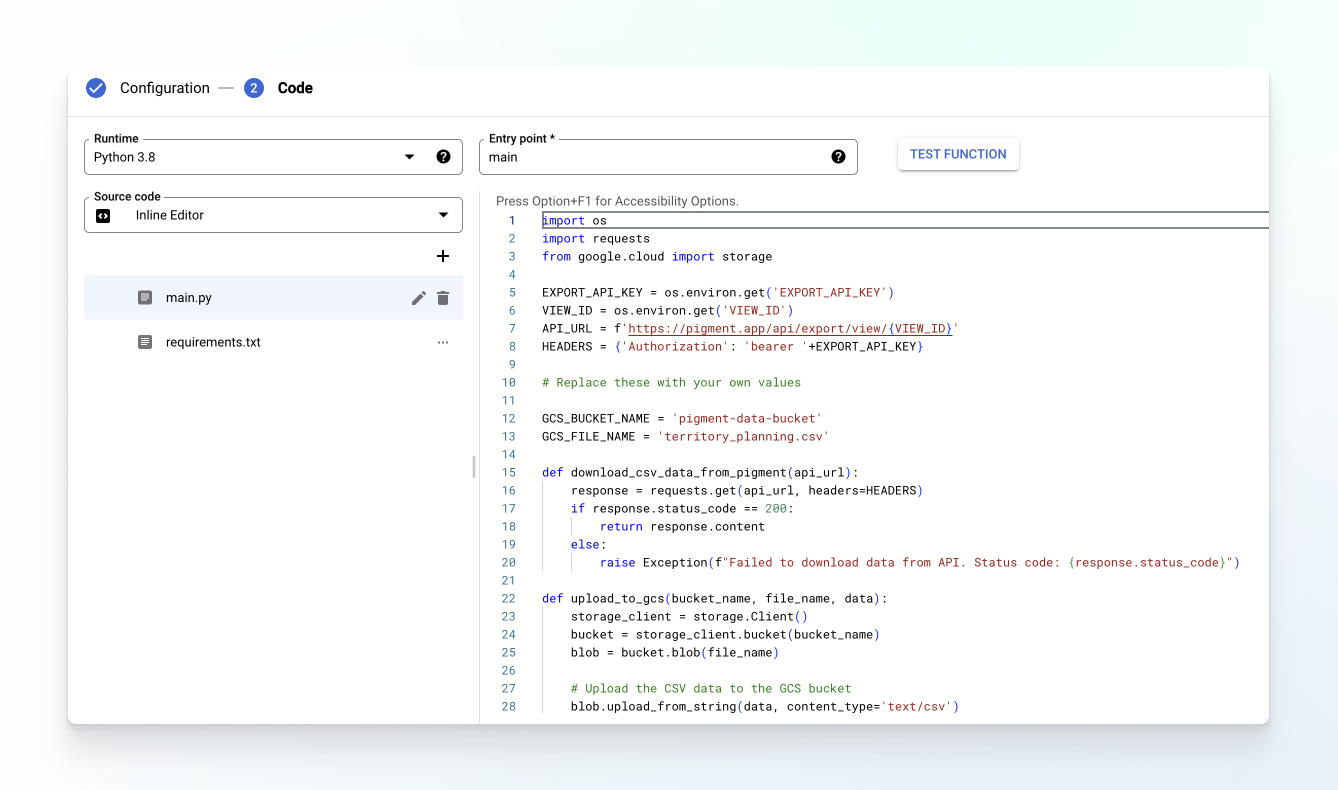
Update the main.py file - In GCS, locate and open the file:
requirements.txt - Paste this text:
google-cloud-storage>=1.36.0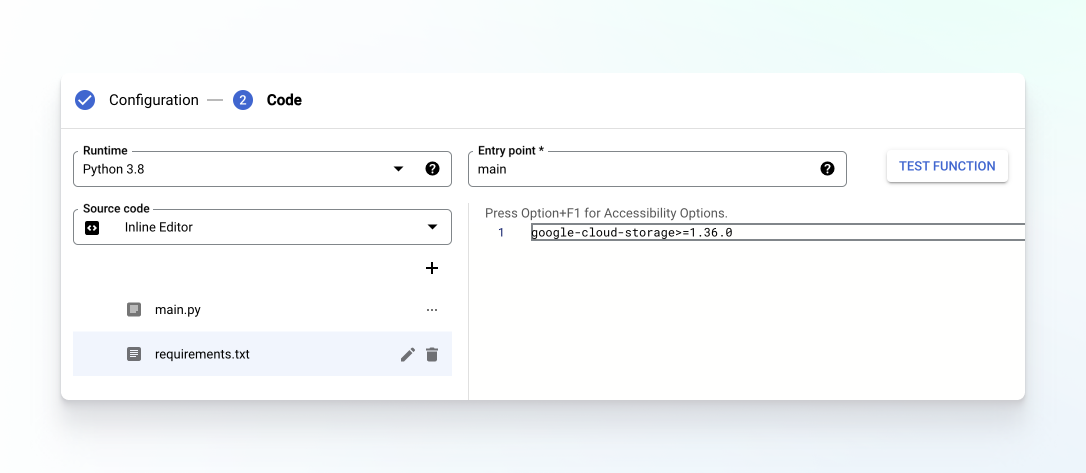
Update the requirements.txt file - Click Deploy.
- (Optional) When your updates are deployed, click Test Function in the Actions menu to test your function.
- Go to your bucket in GCS and locate the file:
filename.csv
You may have renamed this file in step 8e. It contains your exported Pigment API data.
The CSV file containing your exported Pigment data
Schedule regular exports with Cloud Scheduler
You can schedule exporting jobs so that your Pigment data is automatically exported to your CSV file on a regular basis. The example described below uses Cloud Scheduler to import API data to your bucket at 9:00AM GMT daily.
- Go to Cloud Scheduler and select Create Job.
- In the Define the schedule pane, do the following:
a. In the Name field, enter your Scheduler job name.
b. In the remaining fields, set the frequency using a unix-cron format.For more information on using a unix-cron format, see crontab.guru.

Define your schedule
c. Click Continue. - In the Configure the execution pane, do the following:
a. In the Target type menu, select Pub/Sub.
b. In the Select a Cloud Pub/Sub topic menu, select the topic that you created earlier with the Cloud Function.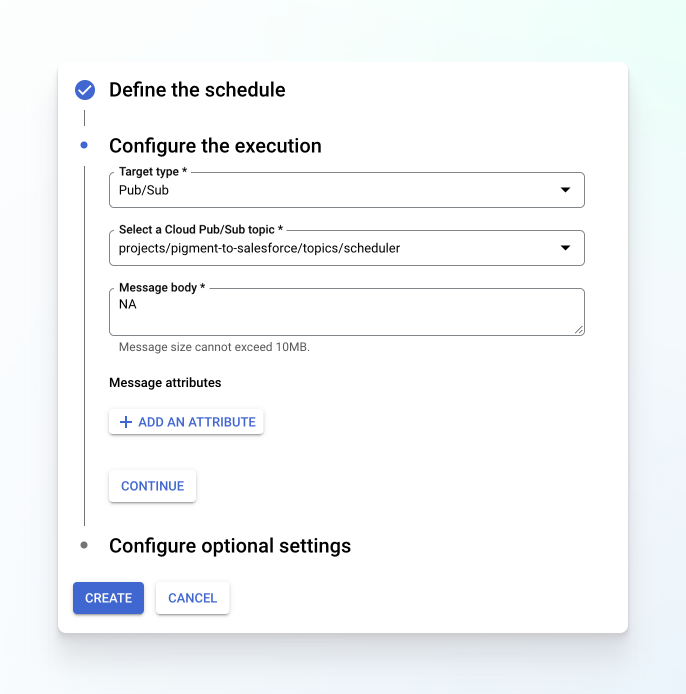
Configure your schedule
c. Click Continue.
Your scheduling job is set up and runs at 9:00AM GMT daily.
